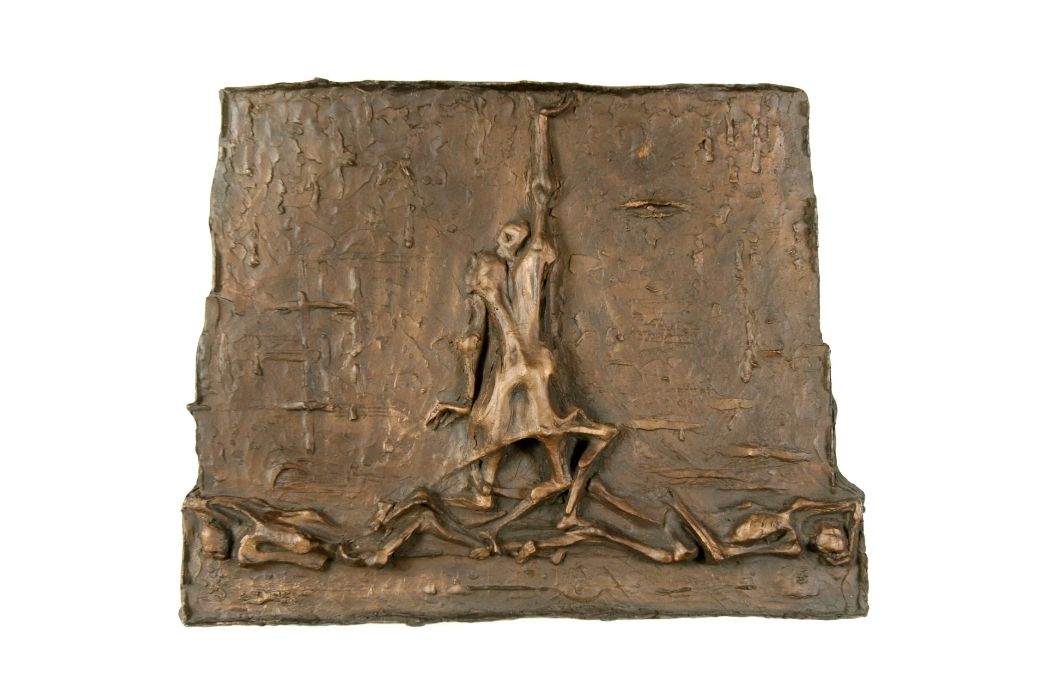
Between 1943 and 1945, 20,000 human beings died in the Mittelbau camps in the Harz Mountains, 6,000 of them between January and April 1945 alone. In memory of the victims of the Mittelbau-Dora concentration camps, the sculptor Theo Balden created a monument that was erected opposite the incineration ovens in the former camp crematorium at the Mittelbau-Dora Concentration Camp Memorial in 1979. The sculptor strove for four years to arrive at the design for this monument. Among the numerous sketches and sculptural studies he made in that process is a relief now in the art collection of the Buchenwald and Mittelbau-Dora Memorials Foundation.
The relief dates from the initial phase of Balden’s work on the monument. Comparison with the final version reveals that he had already gained clarity about fundamental aspects of the design at this early stage. He strove for a parable-like depiction, a metaphorical image that would unite the memory of the victims with the hope of renewed life and a prospect for the future of humanity. In the early stage of his work on the piece, the “phoenix with the long neck of hope” was the “theme of the central axis”. By the final version, the bird that renews itself from ash, a mythical symbol of immortality, had given way to a blossom, the symbol of renewing life, an “allegory of hope […], blossoming, already somewhat withered, and still a bud nevertheless” (from the artist’s diary entries).
Balden’s meaningful artistic conception was motivated by his political conviction of the importance of building a new socialist society and of his role in that process. At the same, his work stood apart from the well-known monuments for the central German Democratic Republic (GDR) memorials in Buchenwald and Ravensbrück. His relief study and the final monument invite many associations and references. Decisive factors for his artistic work were his experiences of exile and the influence of artists such as Henry Moore.
“… under no circumstances should this work become the subject of elaborate indulgence selling. What I don’t want: spiritual absolution through shock. What I do wish: the people upright and watchful, endowed with kindness and power. Ah, what unspeakable, almost impossible things that would mean!”
Theo Balden
Biography
The sculptor Theo Balden was born near Blumenau in the Brazilian district of Santa Catharina, the son of German immigrants. After his father was killed in an accident when he was two, his mother returned to Germany with Theo and his two older siblings. He grew up in modest circumstances. Having finished school, he trained as a technical draughtsman and in 1923 studied briefly at the Bauhaus in Weimar (under Schlemmer and Moholy-Nagy). He joined the German Communist Party in 1928. In 1934, after the National Socialist accession to power, he was arrested by the Gestapo. Released from custody on parole, he fled to Prague under a false name (which he would retain) and in January 1939, shortly before the German occupation of Czechia, to the United Kingdom.
Balden processed his personal experiences as a victim of persecution in drawings and reliefs. The works he executed in exile, particularly Head of a Beaten Jew, are among the earliest in which he explored the persecution and murder of Jews under the National Socialist dictatorship.
After the war Balden participated in exhibitions in Derby, Stoke-on-Trent, and Nottingham before returning to Berlin in 1947. In 1950/58 he taught basic studies at the Hochschule für bildende und angewandte Kunst Berlin-Weißensee, then went into early retirement after a serious illness.
In 1968 he took over the chairmanship of the GDR Cultural Association’s working group for the care of the Barlach oeuvre. In contrast to the sculptural tendencies prevailing in the GDR, which took orientation from the German sculpture tradition, Balden—drawing on the experiences of his years in exile—adopted a metaphorical, non-figurative artistic language to address himself to the theme of human vulnerability. The sculpture for the Mittelbau-Dora Concentration Camp Memorial was one of the few commissions he received for public monuments.
In 1984, the Akademie der Künste der DDR staged a retrospective of his work. He received an honorary doctorate from the University of Greifswald, and in 1990 an honorary professorship at the Hochschule für bildende und angewandte Kunst Berlin-Weißensee. He died in Berlin on 30 September 1995.

